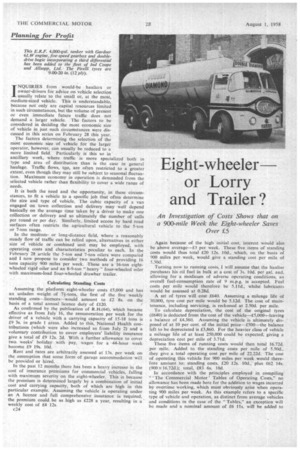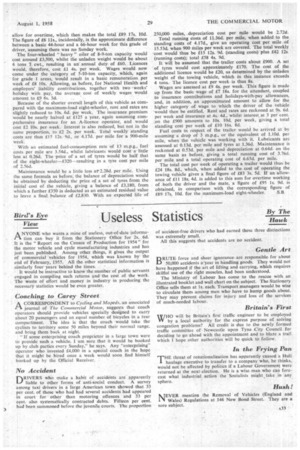Eight-wheeler or Lorry and Trailer?
Page 60

Page 63

If you've noticed an error in this article please click here to report it so we can fix it.
An Investigation of Costs Shows that on a 900-mile Week the Eight-wheeler Saves
Over £5 INQU1RIES from would-be hauliers or owner-drivers for advice on vehicle selection usually relate to the small or, at the most, medium-sized vehicle. This is understandable, because not only are capital resources limited
in such circumstances, but the volume of present or even immediate future traffic does not demand a larger vehicle. The factors to be considered in deciding the most economic size of vehicle in just such circumstances were discussed in this series on February 28 this year.
The factors determining the selection of the most economic size of vehicle for the larger operator, however, can usually be reduced to a more limited field. Particularly is this so in ' ancillary work, where traffic is more specialized both in type and area of distribution than is the case in general haulage. Traffic flows, too, are often restricted to a greater extent, even though they may still be subject to seasonal fluctuation. Maximum economy in operation is demanded from the selected vehicle rather than flexibility to cover a wide range of needs.
It is both the need and the opportunity, in these circumstances, to fit a vehicle to a specific job that often determine the size and type of vehicle. The cubic capacity of a van engaged on town collection and delivery may well depend basically on the average time taken by a driver to make one collection or delivery and so ultimately the number of calls per round or per day. Similarly, limited access by hard road surfaces .often restricts the agricultural vehicle to the 5-ton or 7-ton range.
In the mediumor long-distance field, where a reasonably steady flow of traffic can be relied upon,.alternatives in either size of vehicle or combined unit may be employed, with operating costs and characteristics peculiar to each. In the February 28 article the 5-ton and 7-ton oilers were compared and I now propose to consider two methods of providing 16 tons capacity 900 miles per week. These are a 16-ton eightwheeled rigid oiler and an 8-9-ton " heavy " four-wheeled oiler with maximum-load four-wheeled drawbar trailer.
Calculating Standing Costs
Assuming the platform eight-wheeler costs £5,000 and has an unladen weight of 74-tons, the first of the .five weekly standing costs--licences—would amount to £2 8s. on the basis of a total annual licence duty of £120.
As confirmed by the publication of R.H.(64), which became effective as from July16, the remuneration per week for the driver of a vehicle with a carrying capacity of 15-18 tons is £9 3s. in grade 1 areas. Added to this, National Health contributions (which were also increased as from July 2) and a voluntary contribution to cover employers' liability insurance give a total of £9 12s. 2d. With a further allowance to cover two weeks' holiday with pay, wages for a 44-hour week become £9 19s. 10d.
Rent and rates are arbitrarily assessed at 13s. per week on the assumption that some form of garage accommodation will be provided or hired.
In the past 12 months there has been a heavy increase in the Cost of insurance premiums for commercial vehicles, falling with maximum severity on the eight-wheeler. This is because the premium is determined largely by a combination of initial cost and carrying capacity, both of which are high in this particular example. Assuming the vehicle is operating under an A licence and full comprehensive insurance is required, the premium could be as high as £228 a year, resulting in a weekly cost of £4 12s.
c24 Again because of the high initial cost, interest would also be above average—£3 per week. These five items of standing costs would thus total £20 12s. 10d., which, on the basis of 900 miles per week, would give a standing cost per mile of 5.50d.
Turning now to running costs, I will assume that the haulier purchases his oil fuel in bulk at a cost of 3s. 10d. per gal. and, allowing for a modicum of adverse operating conditions, an overall fuel-consumption rate of 9 m.p.g. is accepted. Fuel costs per mile would therefore be 5.11d., whilst lubricants would be assessed at 0.28d.
A set of tyres will cost £640. Assuming a mileage life of 30,000, tyre cost per mile would be 5.12c1. The cost of maintenance, including servicing, is reckoned at 2.50d. per mile.
To calculate depreciation, the cost of the original tyres (£640) is deducted from the cost of the vehicle—£5,000—leaving a balance of £4,360. Assuming the vehicle is ultimately disposed of at 10 per cent, of the initial price—£500—the balance left to be depreciated is £3,860. For the heavier class of vehicle a mileage life of at least 250,000 could he expected, giving a depreciation cost per mile of 3.71d.
These five items of running costs would then total 16.72d. per mile. Added to the standing costs per mile of 5.50d., they give a total operating cost per mile of 22.22d. The cost of operating this vehicle for 900 miles per week would therefore amount to: standing costs, £20 12s. 10d., plus £62 14s. (900X 16.72d.); total, £83 6s. 10d.
In accordance with the principles employed in compiling The Commercial Motor' Tables of Operating Costs," no allowance has been made here for the addition to wages incurred by overtime working, which must obviously arise when operating 900 miles per week. As this example refers to a specific type of vehicle and operation, as distinct from average vehicles and conditions in the case of the "Tables," an exception will be made and a nominal amount of £6 Ils, will be added to allow for overtime, which then makes the total £89 us. 10d. The figure of £6 us., incidentally, is the approximate difference between a basic 44-hour and a 66-hour week for this grade of driver, assuming there was no Sunday work.
The four-wheeled " heavy " oiler of 8-9-ton capacity would cost around £3,500, whilst the unladen weight would be about 4 tons 7 cwt., resulting in an annual duty of £60. Licences would, therefore, cost £1 4s. per week. Wages would now come under the category of 5-10-ton capacity, which, again for grade 1 areas, would result in a basic remuneration per week of £8 10s. Allowing, as before, for National Health and employers' liability contributions, together with two 'weeks' holiday with pay, the average cost of weekly wages would amount to £9 6s. 3d.
Because of the shorter overall length of this vehicle as compared with the maximum-load eight-wheeler, rent and rates are slightly reduced to 10s. 6d. per week. The insurance premium would be nearly halved at £125 a year, again assuming comprehensive insurance for an A-licence operator, and would cost £2 10s. per week. Interest is also reduced, but not in the same proportion, to £2 2s. per week. Total weekly standing costs are thus £15 12s. 9d., or 4.17d. per mile for a 900-mile week.
With an estimated fuel-consumption rate of 13 m.p.g., fuel costs per mile are 3.54d., whilst lubricants would cost a little less at 0.26d. The -price of a set of tyres would be half that of the eight-wheeler-f 320-resulting in a tyre cost per mile of 2.56d.
Maintenance would be a little less ar2.28d. per mile. Using the same formula as before, the balance of depreciation would be obtained by deducting the price of a set of tyres from the initial cost of the vehicle, giving a balance of £3,180, from which a further £350 is deducted as an estimated residual value to leave a final balance of £2,830. With an expected life of 250,000 miles, ,depreciation cost per mite would be 2.72d.
Total running Costs of 11.36d. per mile, when added to the standing costs of 4.17d., give an operating cost per mile of 15.53d. when 900 miles per week are covered. The total weekly -cost would thus be £15 12s. 9d. (standing costs) plus £42 12s. (running costs); total £58 4s. 9d.
It will be assumed that the trailer costs about £900. A set of tyres would cost approximately £170. The cost of the additional licence would be £20, as determined by the unladen weight of the towing vehicle, which in this instance exceeds 4 tons. The licence cost per week is thus 8s.
Wages are assessed at £9 4s. per week. This figure is made up from the basic wage of £7 18s. for the attendant, coupled to insurance contributions and holidays-with-pay allowances, and, in addition, an approximated amount to allow for the higher category of wage to which the driver of the vehicle would then be entitled. Rent and rates are reckoned at 9s. 6d. per week and insurance at 4s.• 4d., whilst interest at 3 per cent. on the £900 amounts to 10s. 10d. per week, giving a total standing cost per week of £10 16s. 8d. ,
Fuel costs in respect of the trailer would be arrived at by assuming a drop of 3 m.p.g., or the equivalent of 1.10d. per mile, when the vehicle was working with it. Lubricants arc assessed at 0.13d. per mile and tyres at .1.36d. Maintenance is reckoned at 0.53d, •per mile and depreciation at 0.64d. on the same basis as before, giving a total running cost of 3.76d. per mile and a total operating cost of 6.65d, per mile.
The total cost per week of operating a trailer would thus be £24 18s. 8d., which, when added to the cost of operating the towing vehicle gives a final figure of £83 3s. 5d. If an allowance of £11 18s. 4d. is added to this sum for overtime working of both the driver and the mate, a figure of £95 Is. 9d. is obtained, in comparison with the corresponding figure of £89 17s. 10d. for the maximum-load eight-wheeler, S.B.
































































































